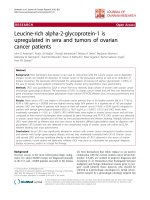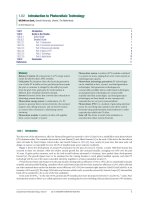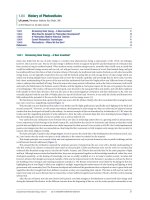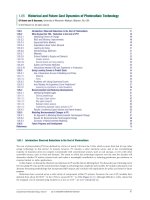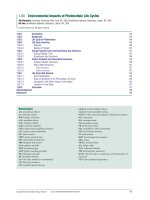Volume 1 photovoltaic solar energy 1 33 – BIPV in architecture and urban planning
Bạn đang xem bản rút gọn của tài liệu. Xem và tải ngay bản đầy đủ của tài liệu tại đây (1.26 MB, 11 trang )
1.33
BIPV in Architecture and Urban Planning
TH Reijenga, BEARiD Architecten, Rotterdam, The Netherlands
HF Kaan, TNO Energy, Comfort and Indoor Quality, Delft, The Netherlands
© 2012 Elsevier Ltd. All rights reserved.
1.33.1
1.33.1.1
1.33.1.2
1.33.2
1.33.2.1
1.33.2.2
1.33.2.3
1.33.2.4
1.33.3
1.33.3.1
1.33.3.1.1
1.33.3.1.2
1.33.3.1.3
1.33.3.1.4
1.33.3.1.5
1.33.3.2
1.33.3.3
1.33.3.3.1
1.33.3.3.2
1.33.3.3.3
1.33.3.4
1.33.4
1.33.4.1
1.33.4.1.1
1.33.4.1.2
1.33.4.1.3
1.33.4.1.4
1.33.4.2
1.33.4.3
1.33.4.4
1.33.5
References
Further Reading
Introduction
Building Integration of Photovoltaics Will Be the Future
Definition of Building Integration
Photovoltaics in the Urban Planning Process
Planning for Renewables
Site Layout and Solar Access
Successful Implementation
Long-Term Operation
Steps in the Design Process with BIPV
Urban Planning – Related Design Aspects
Orientation and angle
Distance between buildings
Trees
Zoning
Reflection
Practical Rules for Integration
Step-by-Step Design
Solar design
Module placement and shadowing
Space required for balance of systems and interconnections
Design Process: Strategic Planning
BIPV in Architecture
Architectural Functions of PV Modules
Roof-integrated PV
Façade-integrated PV
PV in building components
PV art in structures
PV Integrated as Roofing Louvres, Façades, and Shading Devices
Architectural Criteria for Well-Integrated Systems
Integration of PV Modules in Architecture
Concluding Remarks
697
697
698
699
699
699
699
699
700
700
700
700
701
701
701
701
702
702
702
702
702
703
703
703
704
704
704
705
705
706
706
707
707
1.33.1 Introduction
1.33.1.1
Building Integration of Photovoltaics Will Be the Future
Solar systems become an integral part of our society and thus our environment. In various Western countries, and also in Asian
countries like Japan, Malaysia, and China, examples can be seen of large quantities of photovoltaics (PVs), incorporated in urban
areas. There are large incentives for principals to ask for buildings with integrated PVs, and for urban planners and architects to
incorporate PVs into their design. Some countries like France and China will give extra financial incentives for building-integrated
photovoltaic (BIPV) systems.
The government’s role in promoting and supporting sustainable energy (PV systems) strongly influences the extent to which
these systems are used in buildings. The high interest in PV in Germany, for instance, is a result of the policy of the German
government with regards to PV and renewable energy in general. In countries with less government intervention, the power utilities
play a bigger role. Even without financial support, the government can encourage sustainable energy, for example, by demanding
better performance for buildings. By introducing certain energy performance goals, like in the Dutch building code, sustainable
energy and solar energy PV systems might be considered.
A large part of the future PV market will be associated with building applications, especially in Europe, Japan, and China where
the population density is high and the land is valuable. The scale of building integration is increasing and goes up to over 11 MWp
for a building (mainly exhibition or factory halls). In areas with less population, it will be possible to find land for ground-mounted
PV structures.
Comprehensive Renewable Energy, Volume 1
doi:10.1016/B978-0-08-087872-0.00138-4
697
698
Applications
New products are emerging, yet need further development to fully meet the architectural needs of sustainable buildings.
Architects therefore need to start thinking about this new Smart Solar Architecture. This chapter is intended to stimulate this
thinking. The second section focuses on planning aspects of large-scale PV applications. The third section deals with steps in the
design process with BIPV and the third section goes into BIPV in architecture.
1.33.1.2
Definition of Building Integration
It is not easy to formulate a sound definition of BIPV. It not only concerns the physical integration of a PV system into a building,
but it also covers the overall image of the PV system in the building. For the architect, the esthetic aspect, rather than the physical
integration, is the main reason for talking about building integration. The optimal situation is a physically and aesthetically
well-integrated BIPV system. In fact, many examples of physical integration show a lack of esthetic integration. Visual analysis of
PV systems in buildings shows that the look of a poorly designed building does not improve, simply by adding a well-designed
PV system. On the other hand, a well-designed building with a nicely integrated PV system will be accepted by everybody.
Building-integrated, grid-connected PV systems have the following advantages:
•
•
•
•
There is no additional requirement for land.
The cost of the PV wall, and up to a certain point the roof, can be offset against the cost of the building element it replaces.
Power is generated on-site and replaces electricity that would otherwise be purchased at commercial rates.
Connecting to the grid means that the high cost of storage is avoided and security of supply is ensured.
In addition, architecturally elegant, well-integrated systems will increase market acceptance, and BIPV systems provide building
owners with a highly visible public expression of their environmental commitment.
The way people deal with PVs in architecture differs from country to country. This depends on the scale, culture, and type of
financing for building projects. In countries such as Denmark, The Netherlands, and the United Kingdom, where public housing is
very common, serial production is strongly emphasized in housing projects. Professionals such as housing associations, project
developers, and architects implement the housing construction process, in which the main opportunities are for PV roof integration
in single-family terraced houses and for façade and roof integration in apartment buildings (Figure 1).
Of course, there are also many countries where the government or professional, nonprofit housing associations have little
influence on house building. In those countries, the process of developing and building houses is mainly a private initiative.
Integration of PV systems in buildings can be carried out by professionals but, on the smaller scale of a single-family house, the
motivation must mainly come from the private owner. In general, most BIPV systems are found in buildings in which building
professionals are involved. Consequently, in countries where there is little professional involvement in large-scale housing
projects, PV can be found in the first place on commercial and industrial buildings. With these types of buildings, PV systems are
integrated both into façades and roofs. In addition, there is a significant market for private homeowners who buy small-scale
(less than 500 Wp) PV systems and mount them somewhere on their house. However, as these systems are seldom architectu
rally integrated in the building design, we consider these applications as building-added PV (BAPV) systems rather than BIPV
systems.
The aim of integrating PV systems into buildings clearly is to reduce the requirement for land and to reduce the costs [1]. This
could be the cost of the support construction and the cost of building elements, such as cladding elements. It is more efficient to
integrate a PV system when constructing or renovating the building, rather than mounting it afterwards.
Figure 1 The project in Etten-Leur has an ongoing PV roof that connects the detached houses. Each house has its own inverters and monitoring system.
Photograph © Ronald Schlund Bodien.
BIPV in Architecture and Urban Planning
699
1.33.2 Photovoltaics in the Urban Planning Process
In the framework of an EU-supported project ‘PV Upscale’ an inventory was made of the lessons learnt from urban areas all over the
world where large numbers of PV systems have been installed (this section is largely based on Munro [2]). The lessons learnt are
divided into the four main stages of developing an urban area:
1. National and regional policy formation and strategies. These set the context in which urban planners create plans for specific urban
areas and developments.
2. Site layout and initial design. This stage is critical for maximizing the possibilities for installing renewable.
3. Implementation – from design to construction. Good sharing of information and team work are critical at this stage.
4. Occupation – when the real success or otherwise of a project can be seen. It is all too easy to ignore PV systems once they are installed,
but this risks reduction in energy output.
1.33.2.1
Planning for Renewables
In the majority of cities that have installed significant amounts of renewable energy infrastructure over the last 10 years, the local
municipal government has had a key role in stimulating projects. When it comes to installation of large amounts of PV, these cities
tend to have several important factors in common:
•
•
•
•
•
a strong local political commitment to the environment and sustainability;
the presence of municipal departments or offices dedicated to the environment, sustainability, or renewable energy;
obligations that some or all buildings include renewable energy;
information provision about the possibilities of renewable energy;
challenging development sites that have inspired ambitious renewable energy projects.
1.33.2.2
Site Layout and Solar Access
As a solar technology, the success of PV is highly depending on the solar orientation and shading. Consequently, the planning conditions
for PV have to be determined in a very early stage of the urban planning process. Experience has shown that the decision for applying
PV on a larger scale is taken relatively late in the urban planning process, when the site layout has been fixed. As a consequence, the site
may have become less suitable or even almost not suitable for large-scale application of PV. When a municipality or other decision
maker wants to have PV applied in a new urban plan, he should take care that solar energy is considered during the design process.
1.33.2.3
Successful Implementation
The following elements are important for the successful implementation of PVs within the urban renewal and development process:
• Enthusiasm. There has to be some enthusiasm for renewable energy in the design team or the project will not result in the hoped
for emission reduction. If there is no one championing the inclusion of PV, it risks being dropped from the design or will be
poorly integrated.
• Technical knowledge. This will be needed by the system designers and by the rest of the project team.
• Inclusion in the work plan of the entire project team. As designing a BIPV project is based on an integrated design and construction
process, all team members have to be involved from the beginning: architect, structural engineer, electrical engineer, and construc
tion company. Installation of a PV system will affect all members of the team, not just the PV installer.
• Time. The implementation of renewable energy projects has to fit within the construction time schedule or there will be delays and
extra costs.
• Transmission links. A connection to the local electricity network will be needed. The local utility should be informed of the
possibility of any forms of embedded generation at the earliest possible stage.
• Finance. Can the costs come out of the existing budget? If not, can money be raised from external funding sources or innovative
financing?
Good communication between the different members of the project team is also important. Architects and engineers can appear to
speak different languages at the best of times. The problem can be even worse when dealing with a technology that is new to some
members of the team. Clear communication between the members of the team on what they hope PV can offer and the information
they need should be discussed at an early stage in the project.
1.33.2.4
Long-Term Operation
PV systems should have a long lifetime successfully producing electricity at, or close to, their original output level for at least 20 years.
However, experience has shown that while most PV systems reliably supply power for many years, poor implementation, erratic
700
Applications
maintenance, or a lack of forward thinking can lead to loss of performance in the longer term. Experience from around Europe shows
that when large numbers of small PV systems are installed on buildings in urban areas and then left for ordinary building occupants
to operate with no professional support, there are risks that poor performance may not be picked up. This situation contrasts with
one where an individual decision to purchase and install a PV system has been made. In this case, the occupants can be expected to
have some understanding of the system, the quantity of electricity expected to be produced, the guarantees available, and contact
information for the supplier in the event of problems. Nonetheless, issues may still arise in later years if the house is sold on, and the
PV system remains installed on the house. The alternative approach of offering a high feed-in tariff for PV-generated electricity avoids
many problems by providing an incentive to maintain the system.
The various factors that should be considered during the planning and project design stage because they will impact on
long-term performance are as follows:
• The importance of good design and forward planning
• The system performance needs to be checkable
• The completed systems should be handed over to the eventual occupants in full working order, commissioned, and grid
connected
• It is important to look ahead to consider practical and affordable arrangements for maintenance.
1.33.3 Steps in the Design Process with BIPV
1.33.3.1
Urban Planning – Related Design Aspects
The aim of integrating PV systems into buildings is to reduce costs and to optimize the scarce ground in urban areas. To generate
maximum power from building-integrated systems, certain urban planning and architectural aspects have to be taken into account.
The main starting point is the maximum power that can be generated by a system. The primary hindrances can be the (partly)
shadowing of a system by other buildings or objects, and the nonoptimum orientation relative to the sun. Reflection can also be a
problem for the surrounding buildings.
1.33.3.1.1
Orientation and angle
The amount of irradiance depends on the latitude. The maximum irradiance corresponds to surfaces, tilted at an angle equal to
about the latitude minus 10°. For instance at a latitude of 52° N, good results (> 90% of maximum irradiance) can be achieved
by orienting the modules between southeast and southwest, with system angles between 30º and 50º from the horizontal.
Orientations between east and southeast, and between southwest and west, are fairly reasonable with system angles between 10°
and 30° from horizontal. The irradiance will be reduced by around 15% of the maximum.
Flat-roof systems with very low angles (between 5° and 10°) can be a good solution for difficult orientations (as example,
see Figure 2).
1.33.3.1.2
Distance between buildings
Shadowing is a critical issue for BIPV. In general, designs in which the PV modules are shaded for much of the year should be
avoided. For low-rise areas, the problem is easy to solve. The distance between individual houses can be accounted for in designing
BIPV. For mixed height neighborhoods, it will be more difficult. A high-rise apartment building in a low-rise neighborhood can
cause a lot of unwanted shading.
The density of an area is also of high influence. In high-density areas (cities), the distances between buildings are often so small
that there is significant shadowing throughout a large part of the year.
Figure 2 A large-scale application of PV systems for flat roofs. This is a sporting center in Wageningen. Picture © BEARiD Architecten, Tjerk Reijenga.
BIPV in Architecture and Urban Planning
701
As a general note, it is worth mentioning that façade systems (vertical) are more sensitive to shading and need longer distances
from other buildings than tilted systems (roofs). Horizontal systems have a lower irradiance, as previously mentioned, but will be
the best solutions for avoiding shadow. Only neighborhoods with a mixture of low- and high-rise buildings might be unsuitable for
horizontal systems.
1.33.3.1.3
Trees
Greening the area around buildings makes the area look very attractive and the microclimate more comfortable for the inhabitants.
However, the shadowing effect of trees is very important, as the trees will be very dense during the summer. Even during the winter,
when trees lose their leaves, the branches give too much shade.
The aspect of growth is sometimes underestimated. Planning for the future growth of trees is very important and must be done
carefully to avoid problems a few years after the building has been completed or the PV system has been installed.
Solutions can be to
• only plant trees on the north side of buildings,
• plant only small trees up to two-stories high,
• prune trees annually to keep them small.
1.33.3.1.4
Zoning
In future, a special solar zoning will be needed in urban areas with PV systems. The borders of building areas can be clearly marked
on three-dimensional maps to prevent future problems. The amount of sunlight can also be determined on these maps.
1.33.3.1.5
Reflection
Although not a major problem, under certain circumstances, reflection can occur. In low-rise buildings, there are no significant
problems, but in mixed low- and high-rise areas residents in high-rise buildings may experience some annoying reflections if all the
surrounding houses have (glass-covered) PV modules. The fact that there are certain distances between buildings (for shadowing)
may eliminate most of the potential problems.
1.33.3.2
Practical Rules for Integration
There are a few important rules for integrating modules into buildings. These rules concern the functioning and maintenance of the
system, for example:
1. shadow is not allowed on the module,
2. ventilation, that is, cooling, is required at the back of the modules (less important for thin film amorphous silicon, compared to
crystalline silicon),
3. make it easy to mount and remove a module,
4. ensure that the module stays clean or can be cleaned,
5. make easy and reliable electrical connections,
6. ensure that wiring is sun and weatherproof.
Ad 1. As previously mentioned, even partial shadow on the modules will decrease the energy output. Profiled mounting construc
tions, in particular like awnings, can produce shadows along the edge of the adjacent module that will result in loss of
efficiency. Note, for example, the shade in the left part of Figure 2.
Ad 2. Modules with crystalline silicon cells have a higher output when the temperature is lower. With ventilation at the back of the
module, it is possible to keep the temperature low and avoid a decreasing output. However, thin-film amorphous silicon
reacts differently. The higher temperature does not influence the efficiency as much as crystalline silicon. This also holds for
other thin film technologies, such as cadmium telluride.
Ad 3. Although the lifetime of modules is proven to be over 20 years, it is better to know how to remove a single module in the
middle of the installation without removing the whole system. Electrical connections should also be ‘plug and play’. Easy
electrical connections are needed for fast installation and for easy replacement of modules. Depending on the local safety
regulations, precautionary measures should be taken, for example, using lifelines or moveable safety ladders.
Ad 4. The surface of the modules should be clean. Tilted modules will be automatically cleaned by rain in most regions. Modules
mounted at low angles can be treated chemically, which makes the surface smooth and makes cleaning with rain easier. In dry
areas, cleaning should be part of the regular maintenance schedule.
Ad 5. Protect wiring against the weather. Rain is not the main problem, though all connections must be waterproof. Long-term
influence from water should be avoided. Protection against sun and UV light is needed to ensure that the insulation of the
wiring is not deteriorated. Depending on the area, wiring may also need to be protected from small gnawing animals.
702
Applications
1.33.3.3
Step-by-Step Design
A PV system consists of a number of modules with solar cells, an inverter, batteries, or, in most cases, a connection to the
grid. A single house with a small installation can be connected through the existing electricity meter. The electricity that is
produced will be used primarily in the house. Any surplus will be fed into the grid and the meter will spin backwards.
However, not every utility company will allow this and in some cases a second meter is installed. This often happens with
larger systems (more than 2 or 3 kWp). Larger systems or combined systems that are maintained by the utilities are connected
directly to the grid.
1.33.3.3.1
Solar design
To design with PVs the first set of questions are “Why do I want to integrate PV into the building?” and “Is PV needed for general
energy supply, to make the building more independent, or to make a statement about the building’s inhabitants?”
Large systems will be used for general energy supply. This means that large surfaces can be treated in an architectural way.
Different types of modules, shapes, colors, and textures can be used to design the look of the building.
The main issues for a more independent building are the efficiency of the system and the generated yearly output. The size of the
PV system will depend on this and the designer has to allow for a certain number of modules. The designer will probably design
the building around the integrated system, otherwise the system will be something that is connected, but not integrated, into the
building.
1.33.3.3.2
Module placement and shadowing
The first step in the design process will be to look at the number of modules, their dimensions, and the total dimensions of the
system. All these aspects have to be integrated into the roof or façade. Shadowing of the modules is important. A module that is
partly shaded will lose more efficiency than expected. Since all cells of all modules within a string are electrically mounted in series,
one shaded cell will lower the current output of the complete string. Furthermore, the power dissipation in the shaded cell may
cause too high cell temperatures. For that reason, modules contain one or more bypass diodes that create a current bypass for the
shaded cell and for its neighboring cells. Very often a bypass diode covers 18 cells, and as a consequence, one shaded cell causes the
power loss of totally 18 cells (N. van der Borg, private communication, 2011).
1.33.3.3.3
Space required for balance of systems and interconnections
The modules have junction boxes at the back that are connected by cables to the inverters. Space is also required for a junction box
at the back. Together with the ventilation required at the back of the module, this means a gap between 20 and 50 mm
(depending on the size of the junction box) between the back of the module and the mounting surface that can be used for
both functions.
Space is also required for the inverters. For better efficiency, the best place for these inverters is near the modules.
Inverters should be placed in a dry place, possibly inside the building. An AC cable has to be fed from the inverters into the
grid via the meter.
Safety switches are required near the inverters in order to work on the PV system safely. Space for a second utility meter may be
required near the first meter, unless a double meter can be used.
1.33.3.4
Design Process: Strategic Planning
A few procedural steps may be necessary to ensure that the PV system is successfully integrated into the design. A common rule is to
integrate the PV system into the building process without disturbing that process.
Step 1: The first step is consultation with the authorities about local regulations, building permits, and the electrical connection to the grid.
Step 2: The second step is to consult the utility company about the grid connection, electrical diagrams, and the metering system.
Step 3: The third step is the internal meeting with all building partners. A kick-off meeting very early in the process may be useful
to discuss the entire integrated PV system with the building contractor, the roofing company, the electrician, and the PV
supplier.
There are many unique issues to resolve in installing BIPV. The main points in this meeting concern the responsibilities of each party
in the building process. Who is responsible for the waterproofing of the roof – the roofing company or the PV installer? Who is
responsible for electrical safety – the electrician or the PV installer? Who is responsible for safety on the site – the general contractor
or the PV installer? All these aspects must be clearly defined and noted in advance.
Many PV suppliers offer turnkey contracts. This is easy for clients because they receive a complete working system for their
money. However, the client is then responsible for the coordination between PV supplier and building contractor. Placing all
responsibilities with the building contractor means an extra surcharge of perhap. 10% on the cost of the PV system. A good solution
is to make the building contractor (general contractor) responsible for the PV system and negotiate a special fee for coordination
and use of equipment (scaffolds and crane) from the building contractor.
BIPV in Architecture and Urban Planning
703
1.33.4 BIPV in Architecture
This section aims to explain some basic thoughts about PV to nondesigners, from an architectural and design point of view.
Note: All specified power of PV systems is the power under standard test conditions and tilt which may be larger than the power
delivered when installed in nonoptimum orientation required by the BIPV application.
1.33.4.1
Architectural Functions of PV Modules
For architects, the application of PV systems must be part of a whole (holistic) approach. A high-quality PV system can provide a
substantial part of the building’s energy needs if the building has been designed in the right way. However, the energy consumption
for heating, ventilation, and air conditioning (HVAC), lighting, and occupant-related activities in an average house exceeds largely
the possible energy production of a BIPV system. Therefore, the building should be designed and engineered in such a way that the
building-related energy consumption will be substantially lower than in a conventionally designed building.
In a holistic approach, integrating a PV system not only means replacing a building material, thus physically integrating the PV system,
but also aesthetically integrating it into the design. The integration also takes over other functions of the building’s skin. Mounted on a
sloped roof, profile systems mean that PV modules can be part of the watertight skin. As this is a solution which is debatable from the
technical point of view, the system can also be mounted above an impermeable roof foil, thereby protecting the foil against UV light and
direct sun. This extends the life span of the foil. This kind of system is also available for flat roofs. The Powerlight Company from Berkeley,
CA (USA), introduced a PV system into the market that is glued on expanded polystyrene (XPS) insulation material. This type of warm
roof construction (construction on the warm side of the insulation) system is very well suited to renovating large flat roofs.
A distinction can be made between literally integration of PV in the building skin (PV as a cladding element or integrated into the
roof) and integration of PV in building components (awnings, shading devices, etc.) (see examples in Figure 3).
1.33.4.1.1
Roof-integrated PV
A PV system can be integrated into the roof in several ways. One choice is for the integrated system to be part of the external skin and
therefore be part of an impermeable layer in the construction. In the early days of BIPV (1990s), several building projects were
constructed on the basis of this principle. The other choice for roof mounting the PV system is above the impermeable layer. This is a
more secure option but also not without some risk, as the impermeable layer has to be pierced in order to mount the system on the
roof. Using PV modules as roof covering reduces the amount of building materials needed, which is very favorable for a sustainable
building and can help reduce costs.
In addition to covering the complete roof with modules, there are also many products for small-scale use, for example, PV shingles
and tiles. The small scale of these products (from 2 cells on a tile to around 20 cells on a look-alike tile) makes them very convenient
for use in existing buildings or as do-it-yourself products.
(Semi)Transparent PV modules used as roofing materials serve as water and sun barriers and also transmit daylight. In glass-covered
areas, such as sunrooms and atriums, sun protection on the roof is necessary in order to avoid overheating in summer. Transparent PV
modules have the solar cells mounted between two transparent layers (mostly glass), while a certain distance has been kept between
the different cells. The PV cells absorb 70–80% of the sun radiation. The space between the cells transmits enough diffused daylight to
Figure 3 Pictures of different BIPV applications. Pictures from the training CD for IEA PVPS Task 7 [3]. Figure © Mart van der Laan.
704
Applications
Figure 4 PVT façade at RES UK in Kings Langley (UK). Photograph © Henk Kaan.
achieve a pleasant lighting level in the area. In order to increase the usage of daylight in the workplaces, transparent PV modules have
been used instead of glass.
Of course, PV cells convert sunlight into electricity (with typical efficiencies of 6–20%) with the remainder of the solar energy
being converted into heat. This residual heat can also be used to warm the building, for example, by designing an air cavity
underneath the PV modules, through which warm air (heated by PV modules) is flowing. This hybrid collector provides warm air to
the heating system in the home, which in this case, makes it a cost-effective use of the collector.
A relatively new application of PV combined with a thermal system is PVT: a PV module mounted on a solar thermal module.
The residual heat is used to heat the water (or other liquid) in the thermal system. A demonstration project, which was financially
supported by the European Commission, can be seen at the head offices of RES UK in Kings Langley, north of London (UK)
(see Figure 4).
At the Netherlands Energy Research Foundation (ECN) in Petten (NL), Building 42 has a conservatory with 43 kWp BP solar
roof-integrated transparent laminates that reduce light and sun transmission by around 70% as compared to glass. The conservatory
therefore acts as a big parasol over the offices, protecting them from the sun while still providing enough daylight.
1.33.4.1.2
Façade-integrated PV
Façades are basically constructed using in situ bricklaying or concrete constructions, prefab elements, or structural metal façades that
are mounted in place. Concrete constructions form the structural layer and are covered with insulation and a protective cladding.
This cladding can be wood, metal sheets, panels, glass, or PV modules. For luxury office buildings, which often have expensive
cladding, cladding with PV modules is not more expensive than other commonly used materials, for example, natural stone and
expensive special glass. This cladding costs around $1500 m−2, which is considerably larger than the cost of the PV module today.
Structural glazing or structural façades are constructed using highly developed profile systems, which can be filled with all types
of sheeting, such as glass or frameless PV modules.
The development of transparent modules has gone further in the last 10 years. In the semi-transparent modules from the 1990s,
the space between cells and the light transmission through the tedlar back foil stipulated the amount of light that came through.
Starting with the Sunways cells, a complete new generation of light-through cells have been developed like Schott ASI Glass and
Suntech MSK’s light-thru and see-thru cells that can be used in roofs and structural façades.
1.33.4.1.3
PV in building components
Façades are very suitable for all types of sunshading devices, louvres and canopies. There is a logical combination between shading a
building in summer and producing electricity at the same time. Architects recognize this and many examples of PV shading systems
can be seen around the world. A terrace with a roof on the sunny side of a building is a good place for BIPV systems thus providing
shade, protection from rain, as well as electricity.
1.33.4.1.4
PV art in structures
Freestanding applications of PV power systems have been constructed in a variety of more or less creative designs. Well known are
solar sails that are landmarks for companies and show their green involvement. Many other types of freestanding construction
designs to support PV power systems have been constructed. Remarkable are the constructions that show PV as a flower and in some
cases track the sun.
On the small scale, there are many artistic modules both in cell color and pattern or in module form. Artists like Jürgen
Claus (Germany) and Sarah Hall (Canada) became famous as PV artists, and also many architects use PV systems in an artistic
way. The façade of the JingYa hotel in Beijing is huge (designed by Simone Giostra and ARUP for Greenpix). It is in fact a
gigantic 2200 m2 billboard with 2292 modules that collect the energy to lite the light-emitting diode (LED) billboard at night.
BIPV in Architecture and Urban Planning
1.33.4.2
705
PV Integrated as Roofing Louvres, Façades, and Shading Devices
The designer may well use building elements such as canopies and shading systems to integrate PV systems, but will need to look in
detail at shading and PV technology to understand the details of how to design this PV integration. One of the first things that the
designer will discover is the fact that an efficient PV system is not automatically a good shading system. In general, a PV system on
fixed louvres will need a certain mutual distance between the louvres to prevent shading of the cells, which may provide insufficient
shading at a lower sun angle in spring and fall.
Heat load and daylight control systems can be combined with the integration of PV systems. Moreover, when the designer
studies these aspects in detail, he or she will discover that PV systems can also be part of the thermal envelope or thermal system.
Another example is the refurbishment of Building 31 of ECN in Petten (NL). In this project, the PV system is integrated into a louver
system that supports the 35 kWp Shell Solar modules to keep out the summer heat and give less glare, and improve daylight
conditions inside. To prevent shading of the modules by the upper louver, the dimensions of the louvers have to be almost twice the
size of the modules.
Orientation is a major design issue for (green) buildings. The heat load of a building, the need for shading, and the design of
façades all depend on the orientation. Orientation is also important for PV systems. Façade systems might be suitable in certain
countries, especially at a northern (above 50° N) or a southern (below 50° S) latitude. When shading of the façade cannot be
prevented, and for the countries in between these latitudes, sloped surfaces facing the sun or even horizontal surfaces might be more
suitable. The designer’s final choice will be based on orientation, amount of total annual (sun)light on the PV module, shading
from surrounding buildings, and the aesthetics of the design. An important issue for the designer is to appreciate the blue, gray, or
black cells and to become familiar with finding integration opportunities in the first draft design. Ideally, a PV system should not be
added to a building but designed as part of the building.
1.33.4.3
Architectural Criteria for Well-Integrated Systems
In order to decide whether BIPV systems are well integrated, we need to distinguish between the following:
• Technical quality of the integration of the BIPV system, that is, the technical aspects of PV, cables, and inverters,
• Building quality of the BIPV system. Here we look for the quality of the integration of the system as a building element (part of the
roof or the façade that is replaced by modules). The module and its integration must meet typical building standards, such as an
impermeable layer or a structure strong enough to withstand wind or snow loads,
• Aesthetic quality of the BIPV system. This is the least scientific and most subjective part of judging BIPV systems. But the reality is that
architecturally elegant, well-integrated systems will increase market acceptance.
Both the technical and building qualities of the PV system have been considered as preconditions. All installations in a building
must function correctly.
Esthetic quality is not a precondition. The discussion of architectural values is very broad. The average architect is not yet
convinced of the ‘beauty’ of a PV system on the building he/she designs. Some architectural journals [4] have criticized PV projects
in, for example, the 250 kWp project in Sloten, Amsterdam (NL), and the 1.3 MWp project in Nieuwland, Amersfoort (NL), which
are considered by many architects involved in PV projects as shining examples of good integration [5]. All the more reason this
chapter shows some appealing examples and critically judges PV products.
Manufacturers of building elements and products may have a different view on the esthetics of PV. The Monier (Lafarge Braas)
PV 700 roof tile system is a good example of how manufacturers look at their product. This system can be placed invisibly in
between the flat Monier Stonewold tiles.
However, in product advertisements, the manufacturer has chosen tiles with contrasting colors instead of harmonious colors,
thus ignoring the fact that integration, in most situations, should be discreet. After commercial introduction, the system was
prepared for use with a standard roofing tile. This corrugated tile is an even bigger contrast to the flat PV elements. Technically
speaking, this high-quality product has been integrated. Aesthetically, however, the product has not been integrated because of the
contrast. Therefore, the architect, building inspectors, and clients might reject a PV system incorporating this product.
How can we discuss whether a BIPV system is well integrated? A group of architects within the IEA PV Power Systems (PVPS) Task
7 workgroup discussed this subject and came up with several criteria for judging the esthetic qualities of BIPV projects.
The criteria formulated by the IEA PVPS Task 7 workgroup for evaluating the esthetic quality of BIPV systems are as follows:
• natural integration,
• designs that are architecturally pleasing,
• good composition of colors and materials,
• dimensions that fit the gridula (gridula is not a common word outside architectural vocabulary; it denotes the grid that is used for
the design that is a (sometimes hidden) part of the building), harmony, composition,
• PV systems that match the context of the building,
• well-engineered design,
• use of innovative design.
706
Applications
These architectural criteria need to be explained particularly to nonarchitects and manufacturers developing PV systems for
integration into roofs and façades, who often believe that their systems fit perfectly.
• Natural integration. This means that the PV system seems to form a logical part of the building. The system adds the finishing touch
to the building. The PV system does not have to be that obvious. In renovation situations, the result should look as though the PV
system was there before the renovation.
• Architecturally pleasing. The design has to be architecturally pleasing. The building should look attractive and the PV system should
noticeably improve the design. This is a very subjective issue, but there is no doubt that people find some buildings more pleasing
than others.
• Good composition of colors and materials. The color and texture of the PV system should be consistent with the other materials.
• Fit the gridula, harmony, and composition. The dimensions of the PV system should match the dimensions of the building. This will
determine the dimensions of the modules and the building grid lines used (grid = modular system of lines and dimensions used
to structure the building, and should not be mixed up with the electrical grid).
• Matching the context of the building. The entire appearance of the building should be consistent with the PV system used. In a
historic building, a tile-type system will look better than large modules. A high-tech PV system, however, would fit better in a
high-tech building.
• Well engineered. This does not concern the waterproofing or reliability of the construction. However, it does concern the elegance
of the details. Did the designers pay attention to detail? Has the amount of material been minimized? These considerations will
determine the influence of the working details.
• Innovative design. PV systems have been used in many ways but there are still countless new ways to be developed. This is all the
more reason to consider this criterion as well.
1.33.4.4
Integration of PV Modules in Architecture
The above section has discussed in brief the architectural criteria for judging a PV system as such. The following section focuses on
the way in which these systems can be integrated into the architectural concept of the building.
The integration of PV systems in architecture can be divided into five categories:
1.
2.
3.
4.
5.
Applied invisibly
Added to the design
Adding to the architectural image
Determining architectural image
Leading to new architectural concepts.
These categories have been classified according to the increasing extent of architectural integration. However, a project does not
necessarily have to be of a lesser quality just because PV modules have been applied invisibly. A visible PV system is not always
appropriate, especially in renovation projects with historic architectural styles. The challenge for architects, however, is to integrate PV
modules into buildings properly. PV modules are new building materials that offer new designing options. Applying PV modules in
architecture should therefore lead to new designs. In some of the selected projects, the design was based on this principle.
1. Applied invisibly. The PV system has been incorporated invisibly (and is therefore not architecturally ‘disturbing’). The PV system
harmonizes with the total project. An example is the Maryland project in the United States, where the architect tried to integrate
PV modules into the design invisibly. This solution was chosen because the entire project concerned historic architecture.
A modern high-tech PV module look would not be appropriate for this architectural style.
2. Added to the design. The PV system is added to the design. Building integration is not really used here, but this does not necessarily
mean that architectural integration is also lacking. The ‘added’ PV system is not always visible either.
3. The PV system adds to the architectural image. The PV system has been integrated beautifully into the total design of the building,
without changing the project’s image. In other words, the contextual integration is very good.
4. The PV system determines the architectural image. The PV system has been integrated into the design in a remarkable and beautiful
way and plays an important role in the total image of the building.
5. PV system leads to new architectural concepts. Using PV modules, possibly in combination with other types of solar energy, leads to new
designs and new architecture. The integration of PV modules was considered on a conceptual level, which gives the project extra value.
1.33.5 Concluding Remarks
Building integration aims to reduce costs and minimize the requirement for land. To increase market acceptance it is important to
show architecturally elegant, well-integrated systems. Moreover, building owners can show their environmental commitment with
highly visible BIPV systems.
